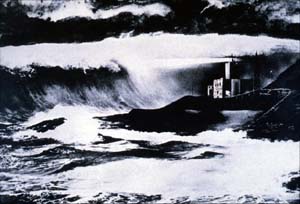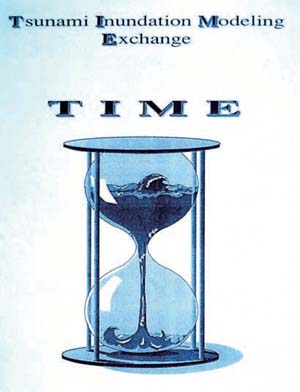Ocean Newsletter
No.107 January 20, 2005
-
The Country that Produced the Internationally Used Word, "Tsunami" What Japan should do
Nobuo Shuto Professor, Faculty of Policy Studies, Iwate Prefectural University / Selected Papers No.7(p.26)
The tsunami that occurred in Sumatra in December 2004 shook the entire world. The videotaped scenes of the horrific tsunami were seen on TV, and there are many people who have just now recognized the horror of tsunami. However, judging from the TV images, the intensity of the tsunami was minor except for Indonesia. Nevertheless, why was so much damage done?I regret speaking unkindly about the dead, but the fact is that the high casualties were the result of a lack of countermeasures against tsunami and a lack of knowledge about tsunamis in general.
Selected Papers No.7(p.26) -
Expectations for the Establishment of an International Research Institute Related to Marine Contamination under Japan's Leadership
Nobuyuki Miyazaki Professor, Ocean Research Institute, The University of Tokyo
Chronic marine contamination has a serious impact on creatures living in the sea, and is closely related to mass death, reproductive disorders, deformations and the declined immune function of living things. Investigations of Caspian seals that have died in large numbers several times in the past show surprising results that include the detection of dozens of times the concentration of organic chlorine-based chemical compounds in comparison with healthy Caspian seals. It is necessary to promote the reinforcement of an international monitoring system, and the establishment of an investigative research organization related to marine contamination.
-
Concept of "Satoumi" Based on Fishery on Tidelands
Norio Kinman Representative, Banzu Satoumi-no-kai
The history of coastal areas along Tokyo Bay is closely related to laver cultivation. The cultivation of asakusanori (laver) used to flourish in Tokyo Bay, and asakusanori being dried in the sun could often be seen anywhere along the coastal areas. Our organization, Banzu Satoumi-no-kai, aims at the realization of satoumi where living creatures, fishermen and citizens can live together through a project for the revival of the perished asakusanori.
The Country that Produced the Internationally Used Word, "Tsunami" What Japan should do
A Giant tsunami seldom occurs, and the full extent of the Sumatra Tsunami cannot be conceived from TV images. Also, as the next giant tsunami may occur only after many generational changes, it is extremely difficult to convey knowledge about it. We can only provide continuous training for disaster prevention and make preparations for tsunamis at every opportunity. Japan, which has suffered more tsunamis than any other country, has numerous technologies that can be transferred to others. Now is the time to utilize them.
1. Why so many casualties?
The tsunami that occurred in Sumatra in December 2004 shook the entire world. The videotaped scenes of the horrific tsunami were seen on TV, and there are many people who have just now recognized the horror of tsunami. However, judging from the TV images, the intensity of the tsunami was minor except for Indonesia. Nevertheless, why was so much damage done?
I regret speaking unkindly about the dead, but the fact is that the high casualties were the result of a lack of countermeasures against tsunami and a lack of knowledge about tsunamis in general.
2. What is a giant tsunami?
 Figure 1: Giant tsunami that hit Unimak Island of the Aleutian Islands in 1946
Figure 1: Giant tsunami that hit Unimak Island of the Aleutian Islands in 1946
At the time of this writing, we do not know the details of the tsunami that hit the coast of Ache Province in Indonesia, but it can safely be said that it must have been a giant tsunami.
Of the past tsunamis that were witnessed in detail, there are some giant tsunamis. In the case of Japan, the Meiji Sanriku Tsunami hit the country in 1896. When the steep front surface of the tsunami came near, houses were blown off by the wind that was generated by the approaching tsunami before it reached the coast. There were places that were hit by a tsunami of almost 40 meters in height. It caused 22,000 deaths. In Iwate Prefecture, 18,000 people were killed, and the remains of 8,000 people were not recovered.
A tsunami of a similar magnitude occurred 50 years later in 1946 in the Aleutians. Figure 1 shows a picture of the Aleutian Tsunami that was painted right after the occurrence of the tsunami by a painter who checked with survivors many times in order to depict the tsunami. The picture was given to the author by Dr. Bernard of NOAA, about 25 years ago, and he noted that the painter's name was no longer known at that time. The front of the tsunami of 30 meters in height stood steep like a cliff, and felled a newly constructed lighthouse with a single blow.
Both giant tsunamis were caused by "a tsunami earthquake," that is, a minor earthquake that causes a major tsunami. Because the earthquake that caused the Meiji Sanriku Tsunami had a seismic intensity of only two, no one thought to evacuate and many lives were lost.
3. Basics of tsunami countermeasures
How should we cope with tsunamis, which are natural phenomena? In 1960 when the Chile Tsunami reached New Zealand, where no earthquake was felt, an ebb tide preceded the tsunami there. It is said that residents of European ancestry who thought the ebb tide an extraordinary sight walked down to the beach, and that the aboriginal inhabitants who thought the ebb tide an abnormal natural phenomenon walked away from the beach. As the latter's attitude of awe for nature will likely disappear in future, we must now make conscious efforts to learn how tsunamis in fact operate.
A tsunami, especially a giant tsunami, occurs at intervals of 100 to 200 years. During the intervals, generations pass, so people's memories wane and the sense of urgency is lost. In order to counter this, there is no way other than continuous education for disaster prevention. Various kinds of countermeasures for disaster prevention are the next step.
4. Necessity of preparation for tsunami countermeasures
 Symbol mark for the Tsunami Inundation Modeling Exchange Project implemented internationally by Tohoku University
Symbol mark for the Tsunami Inundation Modeling Exchange Project implemented internationally by Tohoku University
It is easy to say that the Sumatra Tsunami caused the damage it did because an international tsunami warning system was not in place in the Indian Ocean area, though one was in the Pacific Ocean area. We should ask ourselves, then, if a tsunami forecast system was available in the Atlantic Ocean when a tsunami of 12 meters in height hit Lisbon in 1775 and a tsunami of 10 meters in height hit the Azores Islands in 1855? Even the tsunami warning system based in Hawaii, said to be the only one of its kind in the world, was only established after the Chile Tsunami that occurred in 1960.
It is too late if a cry for countermeasures rises only after the occurrence of a disaster. We should prepare for tsunamis at every opportunity. As an example, if the highprecision buoys for marine observation that Japan began installing near the equator in 1998 had tsunami gauges attached to them, like those provided by the U.S., the buoys would be extremely useful in improving accuracy in the forecasting of remote tsunamis.
What is sought is preparation for a tsunami that may occur at any time. Bewailing the lack of countermeasures after the occurrence of a disaster will not ensure preparedness for the next tsunami.
5. What Japan can do
Japan, which has been hit more often by tsunamis than any other country in the world, is the world's most advanced in terms of preparedness for tsunamis. There are many ways of utilizing that knowledge. One example of utilizing that knowledge is the Tsunami Inundation Modeling Exchange (TIME) Project, which is implemented mostly by the Disaster Control Research Center, Tohoku University. A numerical calculation method used as UNESCO's standard method was adopted, and the method is utilized to prepare hazard maps by countries in danger of being hit by tsunamis.
For comprehensive countermeasures against tsunamis in Japan, three kinds of approaches are combined: one for structures, one for the construction of tsunami-resistant towns, as well as software-oriented countermeasures that include forecasting and warning. Japan has accumulated experience in each of these countermeasures. Because it is now feasible to transfer technology and these countermeasures can be made to fit at applicable points in applicable countries, there is no reason not to make the best use of them.
